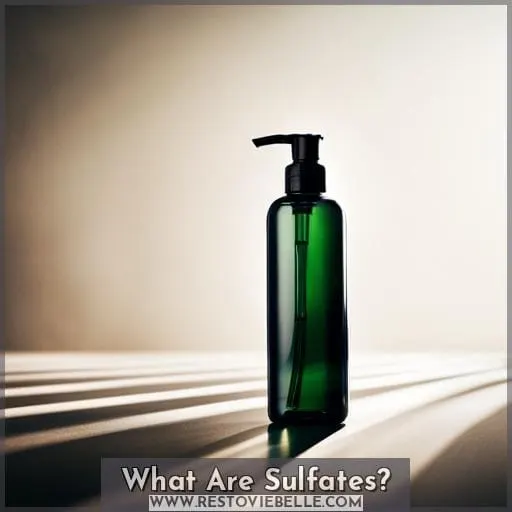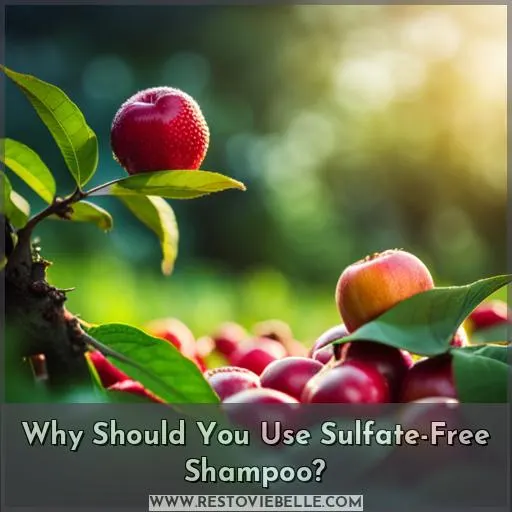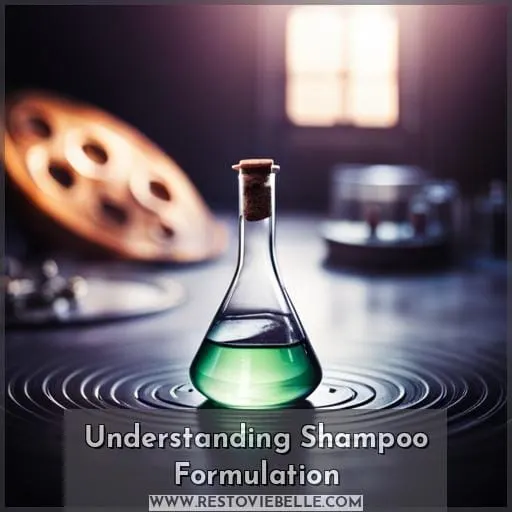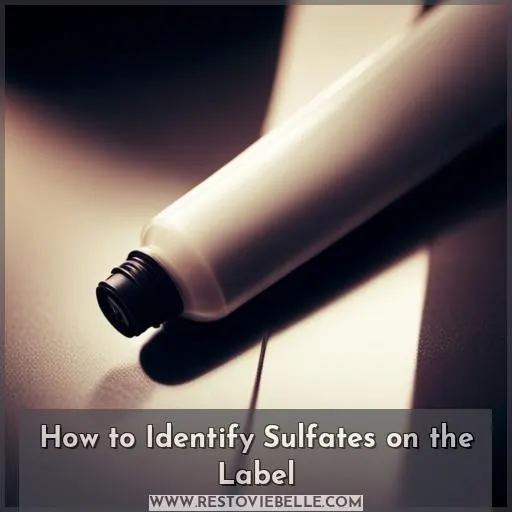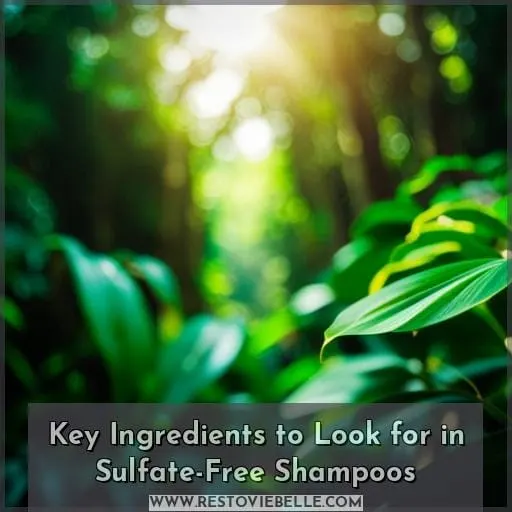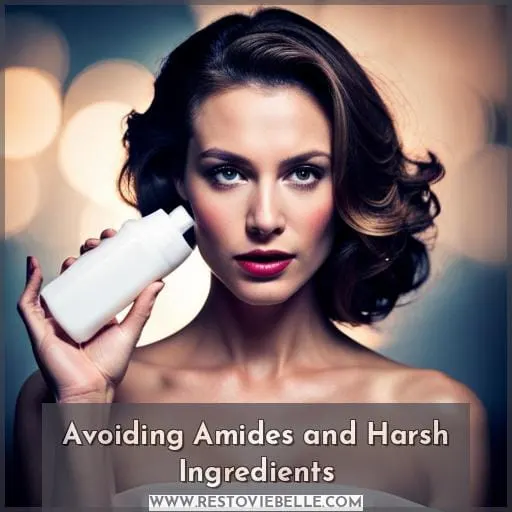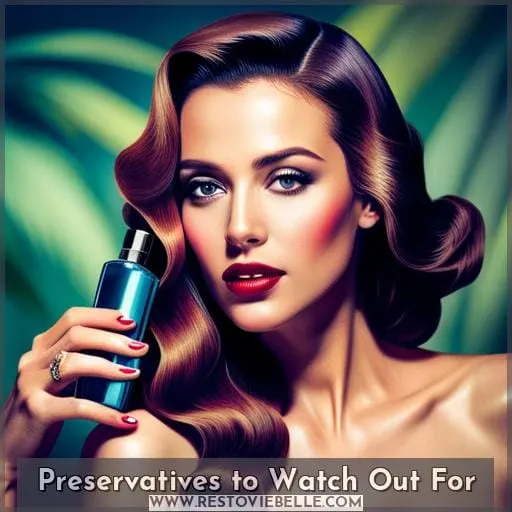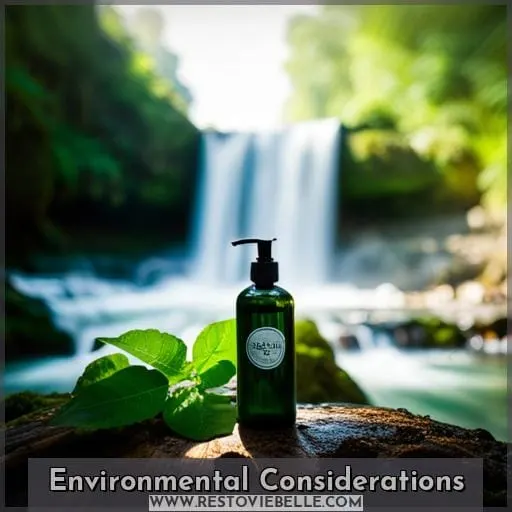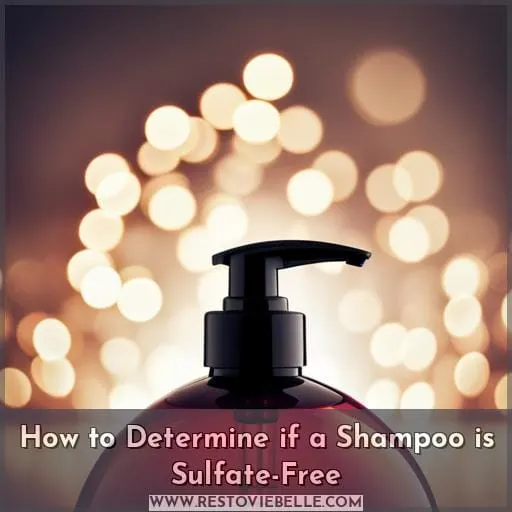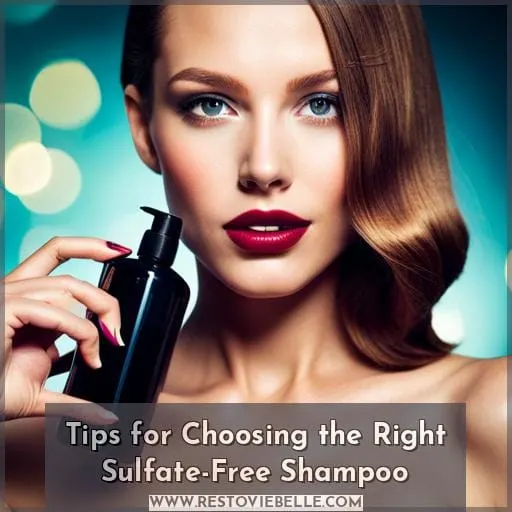This site is supported by our readers. We may earn a commission, at no cost to you, if you purchase through links.
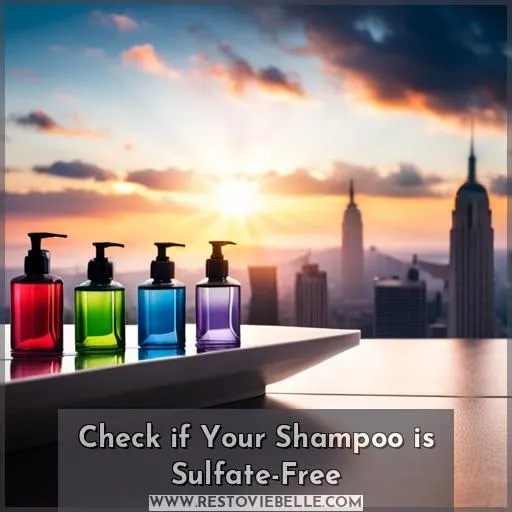 Glittering promises are rarely glittering inside. Here, pure intentions can be masked behind labels for marketing purposes. Let’s uncover what’s in that bottle of sulfate-free shampoo you just bought. You’ll want to understand its formulation before subjecting your scalp and hair to its effects.
Glittering promises are rarely glittering inside. Here, pure intentions can be masked behind labels for marketing purposes. Let’s uncover what’s in that bottle of sulfate-free shampoo you just bought. You’ll want to understand its formulation before subjecting your scalp and hair to its effects.
Some sulfate-free shampoos contain substitutes like cocamide DEA that can be harsher than sulfates themselves. But with a bit of label-reading and ingredient-understanding, you can take control and find a truly gentle, sulfate-free shampoo for your hair’s health and beauty.
Table Of Contents
- Key Takeaways
- What Are Sulfates?
- Why Should You Use Sulfate-Free Shampoo?
- Understanding Shampoo Formulation
- How to Identify Sulfates on the Label
- Key Ingredients to Look for in Sulfate-Free Shampoos
- Avoiding Amides and Harsh Ingredients
- Preservatives to Watch Out For
- Environmental Considerations
- How to Determine if a Shampoo is Sulfate-Free
- Tips for Choosing the Right Sulfate-Free Shampoo
- Conclusion
Key Takeaways
- Sulfates in shampoos can strip natural oils, causing hair damage and scalp irritation.
- Sulfate-free shampoos contain gentle alternatives and beneficial plant-derived ingredients.
- Harmful additives like parabens and formaldehyde-releasing preservatives should be avoided.
- Sulfate-free shampoos help retain moisture, protect hair color, and are suitable for sensitive skin.
What Are Sulfates?
Sulfates are surfactants that create a lather and can strip your hair’s natural oils, so you’ll want to check the labels for them if you’re looking for a gentler shampoo. Common sulfate types include Sodium Lauryl Sulfate (SLS) and Sodium Laureth Sulfate (SLES).
While they do provide good cleansing power, research has shown that overuse of these ingredients can damage hair by stripping away its essential nutrients. Misconceptions around the safety of sulfates have led people to opt for sulfate-free shampoos instead.
These products often contain more moisturizing components which help retain natural color and vibrancy while being gentle on sensitive skin conditions like eczema or rosacea.
To choose an effective yet safe option, look out for alternative surfactants such as Cocamidopropyl Betaine or Coco Glucoside in place of harsher chemicals like Ammonium Lauryl Sulphatte or Lauramide DEA – both known irritants with potential health risks associated with long-term use.
Why Should You Use Sulfate-Free Shampoo?
You may want to consider using sulfate-free shampoo, as it can be beneficial for many hair types and scalp conditions. Sulfates, such as sodium lauryl sulfate (SLS) and sodium laureth sulfate (SLES), are common ingredients in shampoos that produce the lathering effect.
However, they can strip natural oils from the hair, which often results in dryness or damage.
Using a sulfate-free product helps retain moisture while also being gentle on dyed or dry locks. It is ideal for those with sensitive skin or prone to allergic reactions. Many environmental concerns exist when using products containing petroleum-based surfactants like SLS/SLES, so opting out of these altogether is recommended.
Look out for alternatives like cocamide DEA, MEA propylene glycol, hydroxysultaine, etc.
Be aware of preservatives that might release formaldehyde over time too! Finally, choose a shampoo based on your specific needs.
Understanding Shampoo Formulation
In order to properly choose the right shampoo, it’s important to understand how they are formulated and what ingredients to look out for.
Shampoos contain surfactants, which act as lathering agents that help remove dirt and oils from the hair. Sulfates are common surfactants found in shampoos but can be damaging if used too often or on certain hair types.
While sulfate-free formulations may not produce as much lather, they can still effectively cleanse without harming your locks.
To identify a sulfate-free shampoo, check the ingredient listing for any of these common sulphates: sodium lauryl sulphate (SLS), ammonium laureth sulphate (ALS), or ammonium lauryl ether sulpahte (ALES).
Sulfates have become controversial, so alternatives like gentle plant-derived surfactants have been developed instead of traditional chemical makeup.
Look out for other harmful additives such as parabens and BHT/BHA preservatives when choosing a product wisely; some preservatives release formaldehyde over time, which is linked with health risks including cancer development in humans according to recent studies conducted by The National Toxicology Program.
Finally, make sure you select a suitable product based on individual needs – consult an expert if necessary!
How to Identify Sulfates on the Label
By carefully examining the ingredient list on shampoo labels, you can make sure to avoid any harsh ingredients that may damage your hair.
- Check for common sulfate names like Sodium Lauryl Sulfate (SLS) and Sodium Laureth Sulfate (SLES).
- Look for surfactant systems such as Ammonium Laureth Sulfate or TEA Lauryl Sulphonates.
- Scan the product labeling for references to sulfur or sulphur in natural extracts such as sulfur springs water, sulfur oil, etc.
- Read through each chemical name listed in order to recognize other forms of sulfates and derivatives like sodium coco sulphate or ammonium xylene sulphonate.
When searching for a truly sulfate-free solution, look out not only for those chemicals directly related to this group but also their alternatives – from milder nature-derived surfactants like Decyl Glucoside up to harsher ones which are often used instead of traditional synthetic detergents – like Cocamidopropyl Betaine.
When it comes down to it, choosing products without potential irritants is all about having enough knowledge of what the ingredient labels mean and understanding how different components interact with our skin type while still providing us an effective cleansing experience!
Key Ingredients to Look for in Sulfate-Free Shampoos
When shopping for sulfate-free shampoos, it is important to understand what to look for in the ingredients list. Gentle surfactants, plant-derived alternatives, and natural cleansing agents are key components of a safe and beneficial sulfate-free shampoo.
Knowing which ingredients are beneficial can help you find the right product that works best for your particular hair type or needs.
Gentle Surfactants
Gently cleansing your hair without harsh sulfates can be achieved with surfactants such as sodium lauryl sulfonate. For example, a person who experiences dryness and scalp irritation due to shampoos containing SLS might find relief by switching to a milder alternative like plant-derived alternatives or cocamide replacements.
When choosing safe surfactants for shampoo, avoid harmful preservatives and opt for natural or synthetic ones that are gentle on the hair. These include sodium laureth sulfate-free lathers, non-toxic sulfate-alternative surfactants, and mild cationic detergents instead of harsher anionic ones.
With careful selection of ingredients tailored to specific needs, you can enjoy healthy-looking hair without sacrificing cleanliness!
Plant-Derived Alternatives
Discover plant-derived alternatives to sulfates for your shampoo, perfect for keeping hair healthy and hydrated. Organic shampoos offer natural options like coconut oil, jojoba seed oil, aloe vera extract, and tea tree oil to cleanse the scalp and hair without harsh chemicals or surfactants.
Look for gentle surfactants such as decyl glucoside, which is derived from sugar cane. Also, consider lauryl/myristyl glucoside, which are plant-based, cocamidopropyl betaine that comes from coconut oils, and disodium laureth sulfosuccinate that is milder than SLS/SLES.
Choose eco-friendly cleansing with no harmful ingredients like DEA (diethanolamine) or MEA (monoethanolamine). By using sulfate-free choices, you can enjoy beautiful strands while keeping your hair healthy and hydrated.
Natural Cleansing Agents
When choosing a shampoo, look for natural cleansing agents like plant-derived surfactants and be sure to steer clear of sulfate replacements like Cocamide DEA. Coconut derivatives such as cocamidopropyl betaine are gentle yet effective cleansers that can help create a luxurious lather without stripping the hair.
Green ingredients like aloe vera extract or panthenol can also add beneficial properties while avoiding harsh chemicals. Understanding the science of hair care is key to finding safe ingredients in your shampoo formulation that will effectively cleanse and protect your locks from damage caused by overuse of sulfates.
Avoiding Amides and Harsh Ingredients
When shopping for a sulfate-free shampoo, it’s important to be aware of not only the ingredients you’re looking for but also those to avoid. Two key substances to watch out for are amides and harsh surfactants. Cocamide DEA, Lauramide DEA, Sodium Lauryl Sulfonate (SLS), and other similar ingredients can strip moisture from hair strands and lead to allergic reactions with prolonged use.
Instead of these potentially harmful compounds, opt for gentler alternatives like plant-derived surfactants or natural oils. These alternatives will help provide healthier hair without sacrificing lather performance or clarity in the formula.
Taking extra care in reading labels and researching products online can go a long way toward ensuring your choice of shampoo is truly sulfate-free and better suited for protecting your scalp health over time!
Preservatives to Watch Out For
Be wary of preservatives like BHT and BHA that may be lurking in your shampoo. Not all sulfate-free shampoos are created equal, so you should pay special attention to the ingredients list when shopping for a product.
Formaldehyde-releasing preservatives can lead to long-term health concerns if used regularly, so avoid any hair care or scalp care products with these additives.
Toxic chemicals found in some shampoos can also cause irritation and other adverse effects on skin and hair. If you experience any allergic symptoms from using a particular product, consult your dermatologist immediately for further advice.
When choosing sulfate-free shampoo, make sure it is suitable for your specific needs. Consider factors such as color retention, moisture retention, or combating frizziness before making a purchase decision based solely on whether it’s free from certain harsh ingredients.
Do not forget that personal preference plays an important role too!
Environmental Considerations
With sulfates in shampoos stripping natural oils and potentially harming hair, it is no surprise that sulfate-free shampoos are becoming increasingly popular. These products offer moisture retention, gentle cleansing properties, and protection from fading color – all while being eco-friendly.
Harmful effects of sulfates
You may not realize it, but sulfates in shampoo can cause harsh effects to your hair and scalp. These include loss of moisture and damage to the cuticle layer, irritation or sensitivity on sensitive scalps, and worsening conditions such as dandruff for those with a dry scalp.
Sulfate-free shampoos are becoming popular amongst curly communities who care about their hair’s health. They are looking for gentle yet effective cleansing solutions that don’t strip away natural oils from the scalp.
Additionally, they seek solutions with minimal environmental impacts. This is because many sulfates are derived from petroleum sources, which have an adverse effect on our environment when used over time.
Benefits of sulfate-free shampoos
Switching to a sulfate-free shampoo can offer numerous advantages for your hair and scalp. Retaining moisture, protecting hair color, gentle cleansing, and environmental benefits are all hallmarks of these shampoos.
Ideal for those with sensitive skin or conditions like eczema or rosacea, they also help maintain oil control without the harshness of regular products.
Identifying sulfate-free shampoos
Rather than dousing your hair in foaming suds, seek out shampoos where the ingredients shine like a clear mountain stream.
- Reading the ingredient list for sulfates.
- Paying attention to lathering properties.
- Considering specific hair needs.
- Researching unfamiliar ingredients.
Seeking out sulfate-free options supports hair health and a chemical-conscious lifestyle. Factors such as hair type, fragrance preferences, and budget assist in finding the perfect fit.
How to Determine if a Shampoo is Sulfate-Free
One glance over the ingredient list and you’ll be able to spot any pesky sulfates hiding out.
- Check for common sulfate ingredients like SLS, SLES, ALS. These acronyms usually indicate a harsh sulfate.
- Look for alias names like Sodium Lauryl Sulfonate. Marketers use these to disguise sulfates.
- Note the lather factor. Sulfate-free shampoos tend to produce less bubbles. Lots of foam likely means sulfates are present.
- Search for gentle, plant-derived alternatives that clean without stripping like decyl glucoside.
Scrutinizing the ingredients takes some getting used to, but with practice you’ll become a sulfate-sleuthing pro. The sulfate-free benefits like retained moisture and color will make your efforts worthwhile.
Tips for Choosing the Right Sulfate-Free Shampoo
When choosing a sulfate-free shampoo, it is crucial to read the ingredient label thoroughly. Look for any mention of harsh sulfates like sodium lauryl sulfate, as well as sneaky replacements like sodium laureth sulfate, that can damage and dry out hair.
Reading ingredient labels
You’re reading between the lines when scrutinizing ingredient labels. Look for sulfates such as SLS and SLES, plus sodium lauryl sulfonate, cocamide DEA and MEA, propylene glycol, or hydroxysultaine. Beware of formaldehyde donors like BHA and BHT, parabens in synthetic fragrances, glucosides from plants, or amino acid-derived glutamates.
Compare products carefully with allergen awareness to ensure you make an informed choice about your shampoo’s ingredients – because when it comes to finding a sulfate-free solution that works for you.
Identifying sulfate replacements
Be sure to look beyond the label for sulfate replacements like Sodium Lauryl Sulfonate, cocamide DEA, MEA, and propylene glycol.
Just as a scout uses their pocket knife to uncover hidden gems in nature, you can use your sleuthing skills to find shampoos that are free from harsh ingredients.
Look out for safe alternatives such as plant-derived surfactants or sodium lauryl sulfonates.
Be aware of ingredients like Cocamide DEA and Lauramide DEA, which should be avoided due to potential health risks associated with them.
With ingredient awareness and knowledge about available options comes the power of making an informed decision when selecting a sulfate-free shampoo that is suitable for your hair type!
Considering personal hair type
When selecting a sulfate-free shampoo, consider your hair type and preferences to ensure the best results. For fine or greasy hair, look for shampoos that retain moisture and don’t strip away natural oils.
Curly hair may benefit from ingredients like shea butter or avocado oil for extra hydration. Be aware of ingredients that can cause irritation, such as parabens or fragrances, in some shampoos.
Conclusion
Soaring to the top of the list of hair care must-haves is sulfate-free shampoo. It’s unbelievably effective at preserving hair color and texture, which is why the demand for sulfate-free shampoos is higher than ever.
There are many factors to consider before choosing the right shampoo, from understanding the ingredients to understanding your hair type.
The key to checking if a shampoo is sulfate-free is to read the ingredient list and look out for sulfates like SLS and SLES. Identifying sulfate replacements like cocamide DEA, MEA, propylene glycol, and hydroxysultaine will also help determine if a shampoo is sulfate-free.
With the right knowledge and a little precaution, you can ensure your shampoo is sulfate-free and healthy for your hair.
